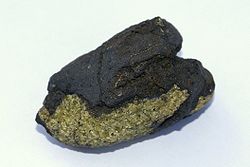- Dunite
-
Not to be confused with Dunnite.
Dunite (
 /ˈdʌnaɪt/ or /ˈdjuːnaɪt/) is an igneous, plutonic rock, of ultramafic composition, with coarse-grained or phaneritic texture. The mineral assemblage is greater than 90% olivine, with minor amounts of other minerals such as pyroxene, chromite and pyrope. Dunite is the olivine-rich end-member of the peridotite group of mantle-derived rocks. Dunite and other peridotite rocks are considered the major constituents of the Earth's mantle above a depth of about 400 kilometers. Dunite is rarely found within continental rocks, but where it is found, it typically occurs at the base of ophiolite sequences where slabs of mantle rock from a subduction zone have been thrust onto continental crust by obduction during continental or island arc collisions (orogeny). It is also found in alpine peridotite massifs that represent slivers of sub-continental mantle exposed during collisional orogeny. Dunite typically undergoes retrograde metamorphism in near-surface environments and is altered to serpentinite and soapstone.
/ˈdʌnaɪt/ or /ˈdjuːnaɪt/) is an igneous, plutonic rock, of ultramafic composition, with coarse-grained or phaneritic texture. The mineral assemblage is greater than 90% olivine, with minor amounts of other minerals such as pyroxene, chromite and pyrope. Dunite is the olivine-rich end-member of the peridotite group of mantle-derived rocks. Dunite and other peridotite rocks are considered the major constituents of the Earth's mantle above a depth of about 400 kilometers. Dunite is rarely found within continental rocks, but where it is found, it typically occurs at the base of ophiolite sequences where slabs of mantle rock from a subduction zone have been thrust onto continental crust by obduction during continental or island arc collisions (orogeny). It is also found in alpine peridotite massifs that represent slivers of sub-continental mantle exposed during collisional orogeny. Dunite typically undergoes retrograde metamorphism in near-surface environments and is altered to serpentinite and soapstone.Dunite may represent the refractory residue left after the extraction of basaltic magmas in the upper mantle. This is the type of dunite found in the lowermost parts of ophiolites, alpine peridotite massifs, and xenoliths. Dunite may also form by the accumulation of olivine crystals on the floor of large basaltic or picritic magma chambers. These "cumulate" dunites typically occur in thick layers in layered intrusions, associated with cumulate layers of wehrlite, olivine pyroxenite, harzburgite, and even chromitite (a cumulate rock consisting largely of chromite). Small layered intrusions may be of any geologic age, for example, the Triassic Palisades Sill in New York and the larger Eocene Skaergaard complex in Greenland. The largest layered mafic intrusions are tens of kilometers in size and almost all are Proterozoic in age, e.g., the Stillwater igneous complex (Montana), the Muskox intrusion (Canada), and the Great Dyke (Zimbabwe). Cumulate dunite may also be found in ophiolite complexes, associated with layers of wehrlite, pyroxenite, and gabbro.
Dunite was named by the Austrian geologist, Ferdinand von Hochstetter in 1859 after Dun Mountain near Nelson, New Zealand. Dunn Mountain was given its name because of the dun colour of the underlying ultramafic rocks. This color results from surface weathering that oxidizes the iron in olivine in temperate climates (weathering in tropical climates creates a deep red soil). Dun Mountain is separated from its sister massif, Red Mountain, at the southern end of South Island, New Zealand, by the Alpine Fault, an approximately 600 km long right lateral strike slip fault similar to the San Andreas fault in California, USA. A massive exposure of dunite in the United States can be found as Twin Sisters Mountain, near Mount Baker in the northern Cascade Range of Washington.
Dunite could be used to sequester CO2 and help mitigate global climate change via accelerated rock weathering. This would involve spreading large quantities of finely ground dunite in tropical regions known near sources of dunite. One significant environmental side effect would be a significant increase in the pH of nearby rivers.
References
- Dunite
- Blatt, Harvey and Robert J. Tracy, 1996, Petrology, 2nd ed., W. H. Freeman, ISBN 0-7167-2438-3
- Peter Köhler, Jens Hartmann, and Dieter A. Wolf-Gladrow. 2010. Geoengineering potential of artificially enhanced silicate weathering of olivine. PNAS ∣ November 23, 2010 ∣ vol. 107 ∣ no. 47 | 20228–20233
Categories:- Ultramafic rocks
- Plutonic rocks
- Plate tectonics
Wikimedia Foundation. 2010.

